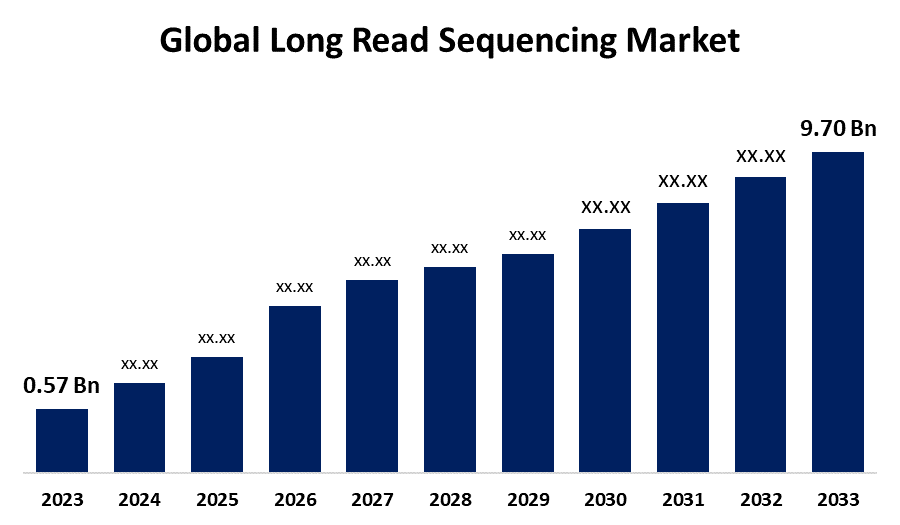Comprehensive historical analysis of Global Long Read Sequencing Market for has thoroughly analyzed in this report. It offers data and insights from 2019-2022, and provides extensive market forecasts from 2023-2032 by region/country and subsectors. It covers the price, sales volume, revenue, historical growth, gross margin, and future outlooks for the Long Read Sequencing market.
The report includes growth prospects in the global Long Read Sequencing market by type, application, sub segement and region and QMI has compiled a comprehensive detailed research report to offer insights. The report details consumption in the Healthcare and other sectors. Regional coverage spans North America, Europe, and rest of the world including Asia Pacific.
Request To Download Free Sample copy of the report @ https://www.sphericalinsights.com/request-sample/7019
The Global Long Read Sequencing Market Size Is Anticipated to Exceed USD 9.70 Billion by 2033, Growing at a CAGR of 32.77% from 2023 to 2033.

In the rapidly evolving field of genomics, long-read sequencing has emerged as a groundbreaking technology, revolutionizing how we understand and analyze genetic information. Unlike traditional short-read sequencing methods, long-read sequencing provides comprehensive insights into complex genomic regions, enabling researchers to uncover previously hidden details about DNA structure and function. According to a recent report by Spherical Insights, the long-read sequencing market is experiencing remarkable growth, driven by advancements in technology, increasing applications in research and diagnostics, and the rising demand for personalized medicine. This blog explores the key trends, challenges, and opportunities shaping this transformative market.
What is Long-Read Sequencing?
Long-read sequencing, also known as third-generation sequencing, is a technique that reads longer stretches of DNA or RNA molecules in a single run. This approach allows for the analysis of complex genomic regions, such as repetitive sequences, structural variants, and epigenetic modifications, which are often difficult to decipher with short-read sequencing. Leading technologies in this space include PacBio's Single Molecule Real-Time (SMRT) sequencing and Oxford Nanopore's nanopore sequencing.
Key Drivers of the Long-Read Sequencing Market
Advancements in Sequencing Technologies
Continuous innovations in long-read sequencing platforms have significantly improved their accuracy, speed, and cost-effectiveness. These advancements are making the technology more accessible to researchers and clinicians, driving its adoption across various applications.Growing Applications in Genomics Research
Long-read sequencing is being widely used in genomics research to study complex genetic variations, such as structural variants, copy number variations, and gene fusions. It is also playing a crucial role in de novo genome assembly, transcriptomics, and epigenetics.Rise of Personalized Medicine
The shift toward personalized medicine, which tailors treatments based on an individual's genetic makeup, is fueling the demand for long-read sequencing. This technology provides detailed insights into an individual's genome, enabling the development of targeted therapies and precision diagnostics.Increasing Focus on Rare Diseases and Cancer Research
Long-read sequencing is proving invaluable in the study of rare genetic disorders and cancer, where complex genomic alterations often play a key role. By identifying these alterations, researchers can better understand disease mechanisms and develop effective treatments.Supportive Government Initiatives and Funding
Governments and private organizations worldwide are investing heavily in genomics research, providing funding and resources to accelerate the development and adoption of long-read sequencing technologies.
Check discount for this report: https://www.sphericalinsights.com/request-discount/7019
Challenges Facing the Market
Despite its potential, the long-read sequencing market faces several challenges:
High Costs
Although the cost of long-read sequencing has decreased over the years, it remains relatively expensive compared to short-read sequencing. This can limit its adoption, particularly in resource-constrained settings.Data Analysis Complexity
The large and complex datasets generated by long-read sequencing require advanced computational tools and expertise for analysis. This can pose a challenge for researchers and clinicians without access to the necessary infrastructure.Limited Awareness and Adoption
In some regions, there is limited awareness about the benefits and applications of long-read sequencing. Educating stakeholders and promoting its advantages is essential for broader adoption.Technical Limitations
While long-read sequencing offers unparalleled insights, it still faces technical challenges, such as higher error rates compared to short-read sequencing. Ongoing research and development are needed to address these limitations.
Opportunities for Growth
Expansion into Clinical Diagnostics
Long-read sequencing has immense potential in clinical diagnostics, particularly for identifying complex genetic variants associated with diseases. As the technology becomes more accurate and affordable, its adoption in clinical settings is expected to grow.Integration with Artificial Intelligence (AI)
The integration of AI and machine learning with long-read sequencing data analysis can enhance the accuracy and efficiency of genomic research. This synergy can unlock new possibilities for understanding complex biological systems.Focus on Emerging Markets
Emerging economies in Asia-Pacific, Latin America, and Africa present significant growth opportunities for the long-read sequencing market. Increasing investments in healthcare infrastructure and genomics research in these regions are driving demand.Development of Portable Sequencing Devices
The development of portable and user-friendly long-read sequencing devices, such as Oxford Nanopore's MinION, is expanding the technology's applications in field research, point-of-care diagnostics, and remote settings.
Access full Report with Table of Content @ https://www.sphericalinsights.com/reports/long-read-sequencing-market
Conclusion
The long-read sequencing market is at the forefront of genomic innovation, offering unprecedented insights into the complexities of the human genome and beyond. With its ability to unravel intricate genetic variations and support advancements in personalized medicine, this technology is poised to transform healthcare and research.
As highlighted in the Spherical Insights report, the future of the long-read sequencing market is bright, with immense opportunities for growth and innovation. For researchers, clinicians, and industry stakeholders, embracing this technology represents a chance to unlock new frontiers in genomics and contribute to a deeper understanding of life itself.
For more detailed insights and data, check out the full report on the long-read sequencing market by Spherical Insights: https://www.sphericalinsights.com/reports/long-read-sequencing-market.
https://www.sphericalinsights.kr/reports/real-estate-tokenization-market
https://www.sphericalinsights.kr/reports/nutraceutical-packaging-market
https://www.sphericalinsights.jp/reports/ethylene-vinyl-alcohol-copolymer-market
https://www.sphericalinsights.jp/reports/climate-tech-market
https://www.sphericalinsights.com/de/reports/automotive-operating-system-market
https://www.sphericalinsights.com/de/reports/vehicle-electrification-market
https://www.sphericalinsights.com/fr/reports/south-africa-point-of-care-ultrasound-market
https://www.sphericalinsights.com/fr/reports/germany-bioremediation-market
https://www.sphericalinsights.com/reports/remote-switch-box-market
https://www.sphericalinsights.com/reports/automatic-tray-retrieval-system-market
https://www.sphericalinsights.com/reports/ezh2-inhibitors-market
https://www.sphericalinsights.com/reports/ovulation-inducing-drug-market
https://www.sphericalinsights.com/reports/blown-rapeseed-oil-market
https://www.sphericalinsights.com/reports/football-helmet-market
https://www.sphericalinsights.com/reports/wedding-loans-market
https://www.sphericalinsights.com/reports/cut-resistant-fabrics-marketAbout the Spherical Insights
Spherical Insights is a market research and consulting firm which provides actionable market research study, quantitative forecasting and trends analysis provides forward-looking insight especially designed for decision makers and aids ROI.
which is catering to different industry such as financial sectors, industrial sectors, government organizations, universities, non-profits and corporations. The company's mission is to work with businesses to achieve business objectives and maintain strategic improvements.
Contact Us:
Company Name: Spherical Insights
Email: sales@sphericalinsights.com
Phone: +1 303 800 4326 (US)














